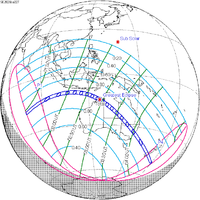|
July 2028 lunar eclipse
A partial lunar eclipse will occur at the Moon’s ascending node of orbit on Thursday, July 6, 2028,[1] with an umbral magnitude of 0.3908. A lunar eclipse occurs when the Moon moves into the Earth's shadow, causing the Moon to be darkened. A partial lunar eclipse occurs when one part of the Moon is in the Earth's umbra, while the other part is in the Earth's penumbra. Unlike a solar eclipse, which can only be viewed from a relatively small area of the world, a lunar eclipse may be viewed from anywhere on the night side of Earth. Occurring about 4 days before apogee (on July 11, 2028, at 18:25 UTC), the Moon's apparent diameter will be smaller.[2] VisibilityThe eclipse will be completely visible over east Africa, Asia, Antarctica, and Australia, seen rising over west and central Africa and Europe and setting over the central Pacific Ocean.[3]
Eclipse detailsShown below is a table displaying details about this particular solar eclipse. It describes various parameters pertaining to this eclipse.[4]
Eclipse seasonThis eclipse is part of an eclipse season, a period, roughly every six months, when eclipses occur. Only two (or occasionally three) eclipse seasons occur each year, and each season lasts about 35 days and repeats just short of six months (173 days) later; thus two full eclipse seasons always occur each year. Either two or three eclipses happen each eclipse season. In the sequence below, each eclipse is separated by a fortnight.
Related eclipsesEclipses in 2028
Metonic
Tzolkinex
Half-Saros
Tritos
Lunar Saros 120
Inex
Triad
Lunar eclipses of 2027–2031This eclipse is a member of a semester series. An eclipse in a semester series of lunar eclipses repeats approximately every 177 days and 4 hours (a semester) at alternating nodes of the Moon's orbit.[5] The penumbral lunar eclipses on February 20, 2027 and August 17, 2027 occur in the previous lunar year eclipse set, and the penumbral lunar eclipses on May 7, 2031 and October 30, 2031 occur in the next lunar year eclipse set.
Half-Saros cycleA lunar eclipse will be preceded and followed by solar eclipses by 9 years and 5.5 days (a half saros).[6] This lunar eclipse is related to two total solar eclipses of Solar Saros 127.
See alsoNotes
External links
|
|||||||||||||||||||||||||||||||||||||||||||||||||||||||||||||||||||||||||||||||||||||||||||||||||||||||||||||||||||||||||||||||||||



























